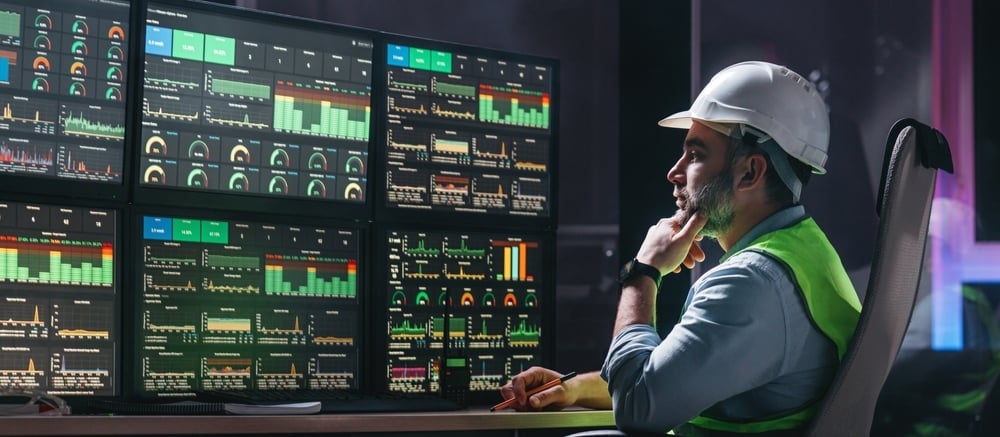
Green Building Trends: The Future of Sustainable Construction
Dive into the top green building trends, including sustainable materials and resilient designs. Learn how these innovations aid net-zero aims.
Sustainability is no longer an option in construction—it’s an expectation. Because the built environment accounts for nearly 40% of global carbon emissions, the industry is under increasing pressure to embrace green building practices that reduce environmental impact while improving efficiency. From innovative materials to cutting-edge energy solutions, the shift toward sustainability is transforming how structures are designed, built, and maintained.
In this article, we’ll explore key trends shaping the future of green building, including the global economic impact of sustainable construction, the role of policy and financial incentives, and emerging technologies that are revolutionizing the industry.
Understanding the Global Influence on Green Building Trends
As green building standards continue to evolve, industry leaders are recognizing the long-term environmental and economic benefits of sustainable design.
Global Market Growth and Economic Significance
The green building market is experiencing unprecedented growth. In 2024, the global sustainable construction materials market was valued at approximately $26.6 billion, and it’s projected to reach $47.9 billion by 2030. This surge reflects a fundamental shift in how the industry approaches development, with a clear focus on long-term cost savings, resilience, and environmental responsibility.
This market growth is fueled by factors like:
- Increased adoption of energy-efficient building materials
- Rising demand for net-zero and carbon-neutral buildings
- Advancements in renewable energy integration
- Corporate and investor interest in sustainable portfolios
The financial benefits of green building are also becoming more apparent. Studies indicate that sustainable buildings have lower operational costs, higher occupancy rates, and increased property values—making them a smart long-term investment.
Regulatory and Financial Drivers
Sustainable construction practices are shifting from voluntary to required as governments worldwide establish stricter sustainability targets. Regulations such as the European Union’s Green Deal and rating systems like LEED are setting new benchmarks for energy efficiency, waste reduction, and carbon neutrality.
In parallel, sustainable financing mechanisms, including green bonds and ESG-driven investments, are making it easier for developers to secure funding for eco-friendly projects. Institutions are increasingly prioritizing projects that align with sustainability goals, offering lower interest rates and financial incentives for buildings that meet rigorous environmental standards.
From tax credits to performance-based funding, the financial landscape is evolving to support the widespread adoption of green construction practices. As a result, companies that invest in sustainable building today are positioning themselves for long-term growth in an increasingly eco-conscious market.
Innovative Practices in Sustainable Construction
Green building trends involve more than using eco-friendly materials. They require industry leaders to rethink how buildings function and interact with their environment. Today’s green building innovations integrate renewable energy, smart technology, and climate-resilient strategies to enhance both efficiency and durability. By embracing these advancements, the construction industry is not only reducing environmental impact, but also creating high-performance structures that can adapt to changing conditions and future challenges.
Adoption of Green Technology and Renewable Energy
The shift toward sustainable construction is being made possible by rapid advancements in green technology and the widespread adoption of renewable energy sources. Solar panels, wind turbines, and geothermal heating systems are now common in both residential and commercial buildings, reducing reliance on fossil fuels and lowering long-term energy costs.
Beyond power generation, smart building technologies are optimizing energy consumption in real time. Automated energy management systems can adjust lighting, heating, and cooling based on occupancy and external weather conditions, significantly reducing waste. Advancements in battery storage allow buildings to store excess renewable energy for later use, increasing energy independence and resilience.
While green building trends don’t focus solely on eco-conscious materials, new materials are emerging that further enhance sustainability. Carbon-negative concrete, self-healing bio-based insulation, and reflective roofing materials are helping minimize environmental impact while improving building efficiency. As these technologies become more accessible, the industry is moving closer to a future where buildings generate as much energy as they consume—if not more.
Resilient Design Against Extreme Weather
With climate change leading to more frequent and severe weather events, resilient design has become a critical aspect of sustainable construction. Extreme heat, heavy storms, rising sea levels, and wildfires all pose significant threats to the built environment. To counteract these risks, architects and engineers are prioritizing durability, adaptability, and climate-responsive design.
For example, flood-resistant construction incorporates elevated foundations, permeable pavement, and advanced drainage systems to protect buildings in flood-prone areas. In regions vulnerable to wildfires, fire-resistant materials, ember-resistant vents, and defensible landscaping are being integrated into designs to mitigate fire risk.
Hurricane-resistant structures are also becoming more prevalent. Reinforced framing, impact-resistant glass, and aerodynamic designs help buildings withstand high winds and flying debris. These strategies enhance safety and contribute to long-term cost savings by reducing the need for repairs and reconstruction after extreme weather events.
Advancing Construction in the Circular Construction Economy
The transition to a circular construction economy is redefining sustainability in the built environment. Instead of the traditional linear model—where materials are extracted, used, and discarded—circular construction emphasizes reuse, recycling, and resource efficiency.
By designing buildings with longevity in mind and repurposing materials at the end of their life cycle, the industry can significantly reduce waste and minimize environmental impact. This approach conserves natural resources, lowers costs, and improves overall project sustainability.
Below, we’ve outlined a few key sustainable construction initiatives across the globe that are driving the circular construction economy.
Construction Initiatives in Europe and Singapore
In Europe, strict waste reduction policies and ambitious sustainability goals are driving the adoption of circular building practices. The European Commission’s Circular Economy Action Plan prioritizes material reuse, modular construction, and eco-friendly design principles. Amsterdam, for example, is implementing circular building strategies that require at least 50% of materials in new construction to be reused or recycled by 2030. Finland’s roadmap for a circular economy integrates sustainable infrastructure projects that extend the life cycle of materials and minimize waste.
Singapore has also emerged as a leader in circular construction. The country’s Zero Waste Masterplan focuses on reducing construction and demolition waste through advanced recycling processes and material repurposing. The government actively promotes circular design principles by encouraging modular and prefabricated construction methods that reduce material waste and increase efficiency. Through initiatives like the Green Building Masterplan, Singapore continues to push for a more resource-efficient future in construction.
TRUE (Total Resource Use and Efficiency) and Waste Management
Effective waste management is a cornerstone of circular construction, and certification programs like TRUE (Total Resource Use and Efficiency) are helping to standardize best practices across the industry. TRUE certification encourages companies to adopt zero-waste strategies that prioritize material recovery, responsible procurement, and landfill diversion, such as:
- Deconstruction over demolition: Salvaging materials such as steel, wood, and concrete for reuse in future projects.
- Material tracking and audits: Monitoring waste streams to identify opportunities for reduction and recycling.
- On-site waste sorting and processing: Separating materials at construction sites to streamline recycling and repurposing.
- Sustainable sourcing: Choosing reclaimed or recycled materials to reduce demand for virgin resources.
The Role of International Agreements in Green Building
International agreements shape green building trends by setting global standards for sustainability and carbon reduction. These agreements provide a framework for governments, industries, and businesses to adopt environmentally responsible construction practices, aligning the built environment with broader climate goals.
Paris Agreement and Net-Zero Emissions Commitments
The Paris Agreement is one of the most influential global accords in the fight against climate change. It aims to limit global warming to well below 2°C and launches efforts to keep it under 1.5°C. The construction industry plays a critical role in achieving these targets.
To align with the Paris Agreement’s objectives, many countries and corporations have set ambitious net-zero emissions commitments. This includes:
- Energy-Efficient Building Codes: Governments worldwide are tightening regulations to ensure new buildings meet stricter energy performance standards. Passive house principles, net-zero buildings, and smart energy systems are becoming the norm rather than the exception.
- Decarbonization of Building Materials: The industry is investing in low-carbon alternatives, such as carbon-negative concrete, sustainable timber, and recycled steel, to lower the embodied carbon footprint of construction projects.
- Electrification and Renewable Energy Integration: Builders are increasingly incorporating on-site renewable energy solutions, such as solar panels and geothermal heating, to reduce operational emissions and reliance on fossil fuels.
- Retrofitting and Renovation: Improving the energy efficiency of existing buildings through insulation upgrades, smart HVAC systems, and LED lighting retrofits is a cost-effective way to cut emissions and extend the lifespan of structures.
Countries and organizations leading the charge in net-zero construction include those committed to the Global Alliance for Buildings and Construction and initiatives like the Race to Zero campaign. As international agreements continue to evolve, the construction industry must remain proactive in adopting policies and technologies that drive meaningful, lasting environmental impact.
Sustainable Building Materials: What’s New in 2025?
As the demand for greener construction continues to rise, the industry is embracing new materials that lower carbon footprints, improve energy efficiency, and enhance building longevity. From recycled content to bio-based alternatives, the latest advancements are pushing the boundaries of sustainable design. Some of the most up-and-coming sustainable building materials are:
- Recycled concrete and aggregate: Crushed and repurposed from demolished structures, reducing the demand for virgin materials.
- Reclaimed wood: Sourced from old barns, factories, and shipping pallets, offering a rustic aesthetic while preventing deforestation.
- Steel and aluminum with high recycled content: Lowering energy-intensive manufacturing while maintaining strength and resilience.
- Hempcrete: A bio-composite made from hemp fibers, lime, and water, offering insulation and carbon sequestration benefits.
- Mycelium-based insulation: Grown from fungi, this biodegradable insulation is lightweight, fire-resistant, and free from harmful chemicals.
- Cross-laminated timber (CLT): A sustainable alternative to concrete and steel, CLT provides strength, durability, and carbon sequestration benefits.
- Aerogel insulation: A highly effective insulator derived from silica, offering superior thermal resistance with minimal thickness.
- Vacuum insulated panels (VIPs): Ultra-thin panels with exceptional insulating properties, ideal for space-saving applications.
- Phase change materials (PCMs): Designed to absorb and release heat to regulate indoor temperatures and reduce HVAC loads.
- Low- and zero-VOC paints: Eliminating harmful volatile organic compounds to improve indoor air quality.
- Natural clay and lime plasters: Offering breathable, non-toxic alternatives to synthetic wall finishes.
- Self-healing concrete: Infused with bacteria or polymers that repair cracks when exposed to moisture, extending structural lifespan.
- Solar-reflective roofing: Reducing heat absorption and lowering cooling costs by reflecting more sunlight.
The Future of Green Building Trends in Construction with Vitruvi Software
Sustainability is the future of construction. As the industry moves toward net-zero buildings, circular economy principles, and resilient design, green building trends are driving efficiency, reducing environmental impact, and improving long-term project viability. With increasing market growth, stricter regulations, and advancements in materials and technology, construction professionals must adapt to meet evolving sustainability standards.
To navigate these changes effectively, teams need tools that streamline project management and ensure compliance with green building goals. Vitruvi Software provides an integrated construction management platform that optimizes workflows, enhances collaboration, and tracks sustainability metrics in real time, making it easier to build efficiently and responsibly.
Take the next step toward sustainable construction—Book a demo with Vitruvi Software today.
Subscribe and stay up to date with the newest posts delivered right to your inbox!

